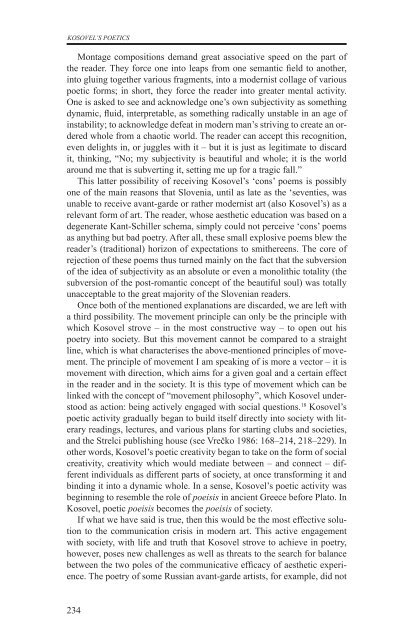razprave (pdf) - Društvo za primerjalno književnost - ZRC SAZU
razprave (pdf) - Društvo za primerjalno književnost - ZRC SAZU
razprave (pdf) - Društvo za primerjalno književnost - ZRC SAZU
- No tags were found...
You also want an ePaper? Increase the reach of your titles
YUMPU automatically turns print PDFs into web optimized ePapers that Google loves.
KOSOVEL’s poeticsMontage compositions demand great associative speed on the part ofthe reader. They force one into leaps from one semantic field to another,into gluing together various fragments, into a modernist collage of variouspoetic forms; in short, they force the reader into greater mental activity.One is asked to see and acknowledge one’s own subjectivity as somethingdynamic, fluid, interpretable, as something radically unstable in an age ofinstability; to acknowledge defeat in modern man’s striving to create an orderedwhole from a chaotic world. The reader can accept this recognition,even delights in, or juggles with it – but it is just as legitimate to discardit, thinking, “No; my subjectivity is beautiful and whole; it is the worldaround me that is subverting it, setting me up for a tragic fall.”This latter possibility of receiving Kosovel’s ‘cons’ poems is possiblyone of the main reasons that Slovenia, until as late as the ‘seventies, wasunable to receive avant-garde or rather modernist art (also Kosovel’s) as arelevant form of art. The reader, whose aesthetic education was based on adegenerate Kant-Schiller schema, simply could not perceive ‘cons’ poemsas anything but bad poetry. After all, these small explosive poems blew thereader’s (traditional) horizon of expectations to smithereens. The core ofrejection of these poems thus turned mainly on the fact that the subversionof the idea of subjectivity as an absolute or even a monolithic totality (thesubversion of the post-romantic concept of the beautiful soul) was totallyunacceptable to the great majority of the Slovenian readers.Once both of the mentioned explanations are discarded, we are left witha third possibility. The movement principle can only be the principle withwhich Kosovel strove – in the most constructive way – to open out hispoetry into society. But this movement cannot be compared to a straightline, which is what characterises the above-mentioned principles of movement.The principle of movement I am speaking of is more a vector – it ismovement with direction, which aims for a given goal and a certain effectin the reader and in the society. It is this type of movement which can belinked with the concept of “movement philosophy”, which Kosovel understoodas action: being actively engaged with social questions. 18 Kosovel’spoetic activity gradually began to build itself directly into society with literaryreadings, lectures, and various plans for starting clubs and societies,and the Strelci publishing house (see Vrečko 1986: 168–214, 218–229). Inother words, Kosovel’s poetic creativity began to take on the form of socialcreativity, creativity which would mediate between – and connect – differentindividuals as different parts of society, at once transforming it andbinding it into a dynamic whole. In a sense, Kosovel’s poetic activity wasbeginning to resemble the role of poeisis in ancient Greece before Plato. InKosovel, poetic poeisis becomes the poeisis of society.If what we have said is true, then this would be the most effective solutionto the communication crisis in modern art. This active engagementwith society, with life and truth that Kosovel strove to achieve in poetry,however, poses new challenges as well as threats to the search for balancebetween the two poles of the communicative efficacy of aesthetic experience.The poetry of some Russian avant-garde artists, for example, did not234
















